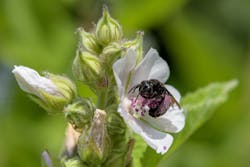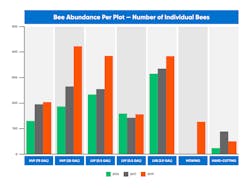Every June, National Pollinators Month brings attention to the important role pollinators play in the development of flowering plants and the production of our global food supply. Approximately 1 in every 3 bites of food contains pollination-dependent produce, including a variety of fruits, nuts and vegetables. While pollinators continue to play a pivotal role in food source production for humans and wildlife alike, habitat loss, degradation and fragmentation have been a leading cause of declining pollinator populations since the 1990s. Despite this concerning trend, utility rights-of-way (ROW) provide bountiful landscapes where biodiverse habitat can be developed to support pollinators and a variety of other wildlife species.
Effectively managing incompatible vegetation throughout utility ROW can provide early successional habitat that is not only compatible with electrical powerlines but also favored by a variety of floral and faunal species. These results can be achieved through Integrated Vegetation Management (IVM), which uses various vegetation management strategies to control incompatible plant species and support the development of desirable low-growing native plant communities.
With the support of Corteva Agriscience and other environmentally minded funding partners, the State Game Lands 33 (SGL 33) research project in central Pennsylvania has tested and analyzed the environmental effects of various vegetation management strategies throughout utility ROW since 1953. Most recently, the focus of this research was dedicated to studying the impact of different vegetation control methods associated with IVM on a number of floral and faunal species over a three-year span. Goals for this research included the collection of flower-visiting insects throughout utility ROW corridors as these sites represent ideal landscapes for pollinator habitat to exist.
Understanding Plot Development
To support this study, SGL 33 researchers assessed and compared the diversity, abundance and taxa richness of bees on surveyed plots to which five different vegetation management strategies were tested. Results from these plots, which were assessed between 2016 and 2019, reflected the environmental impact of the following treatments:
· Mechanical mowing
· Hand-cutting
· High-volume foliar (HVF) herbicide application
· Low-volume foliar (LVF) herbicide application
· Low-volume basal (LVB) herbicide application
Each test plot measured 2.5 to 3 acres in size and was managed to include a 95-foot wire zone and 30-foot border zone on each side of the transmission line corridor. While mowing plots were added in July 2019, the terrain for hand-cut plots was unequal to other plots, resulting in the presence of fewer flowering plants upon treatment. With these discrepancies in mind, vegetation managers are encouraged to consider three key findings from the Floral and Faunal Research Report provided by SGL 33 researchers with Pennsylvania State University:
1. Hand-cutting and mowing plots featured a lower abundance of bees than most herbicide-treated plots.
Herbicide-based treatments consistently outperformed hand-cutting and mechanical mowing practices in terms of total bees per plot. In addition to collecting only 52 total bees from the hand-cutting plot in 2019, researchers collected 128 bees from the mowing plot. By 2019, the quantity of individual bees on plots to which HVF (205; 423), LVF (386; 157) and LVB (385) treatments were applied, significantly outperformed these metrics, as detailed in the chart below:
State Game Lands 33 Research Report to Cooperators: 2018-2021.
2. Herbicide-treated plots yielded higher levels of taxa richness
While complete identifications and multi-year comparisons of bee taxa richness for SGL 33 will be verified later this year, researchers collected 107 tentative bee taxa at SGL 33 in 2019. The most were collected on the HVF plot to which 25 gallons of herbicide were applied, and the fewest were collected from the hand-cutting plot. Other herbicide-treated plots outperformed mechanical control methods as well:
· Hand-cutting: 26 taxa
· Mechanical mowing: 29 taxa
· HVF (75 gallons): 46 taxa
· HVF (25 gallons): 61 taxa
· LVF (0.5 gallon): 47 taxa
· LVF (0.5 gallon): 53 taxa
· LVB (2.9 gallons): 47 taxa
3. Low-volume basal applications yielded the most consistent results
Bee abundance increased from one year to the next for most herbicide-treated plots, and the LVB unit featured a consistently high abundance and taxa richness of native bees across all three years after treatment. The mechanical mowing plot featured the second-lowest abundance of individual bees next to the hand-cutting plot, and both yielded significantly lower levels of abundance and taxa richness across all three years of study.
Results from the past three years of SGL 33 research add to decades of environmental studies that support the use of selective herbicide applications as part of an IVM-based approach. Utility ROW represent ideal landscapes that can support at-risk pollinator species. By using herbicides selectively, utility vegetation managers have the ability to not only protect utility infrastructure from encroaching trees and other incompatible plant species, but also support the development of biodiverse habitat for bees and other pollinator species.
As a funding partner of SGL 33 research, Corteva Agriscience launched a digital resource that shares environmental research insights, effective herbicide programs and application success stories with vegetation managers from across the country. For access to these insights, visit HabitatWithHerbicides.com.
™ Trademarks of Corteva Agriscience and its affiliated companies. © 2022 Corteva.
Sponsored By:


